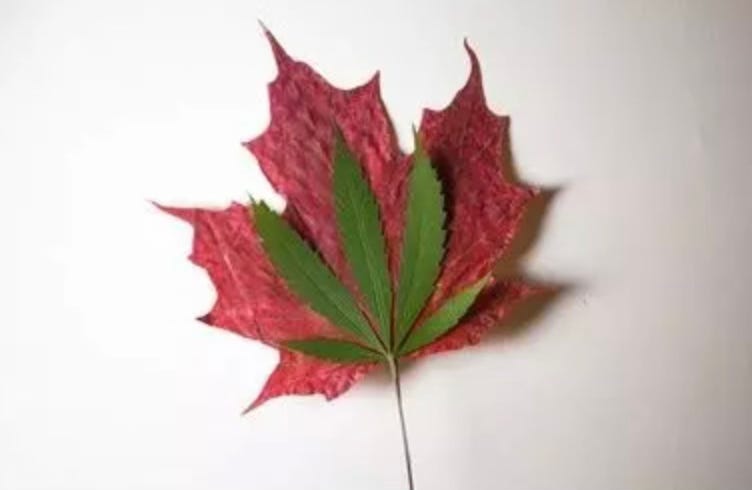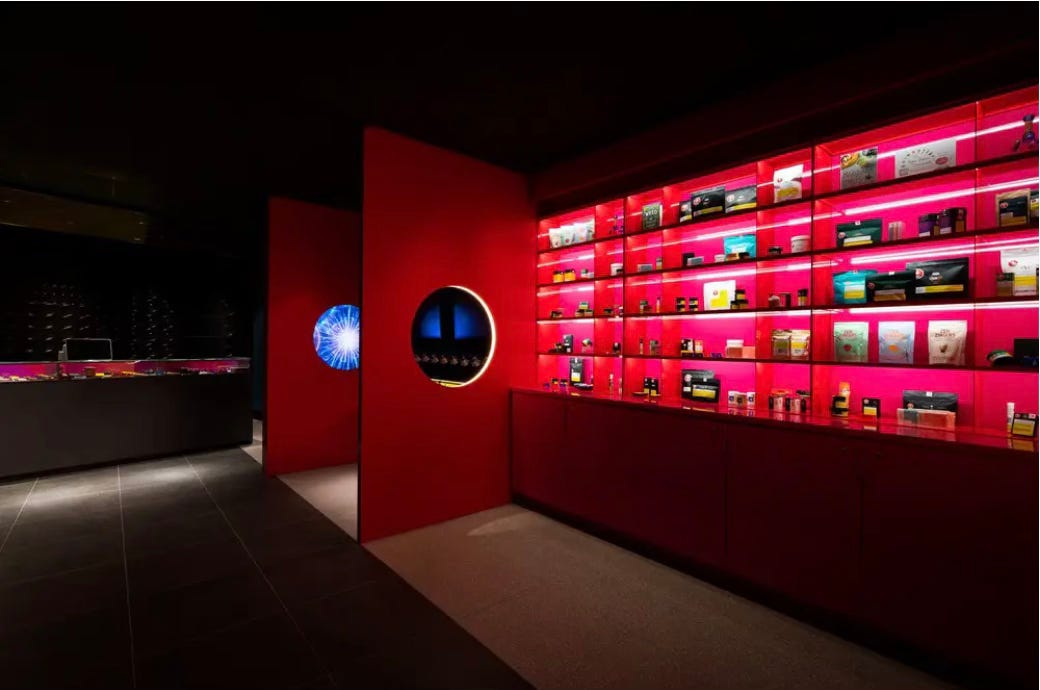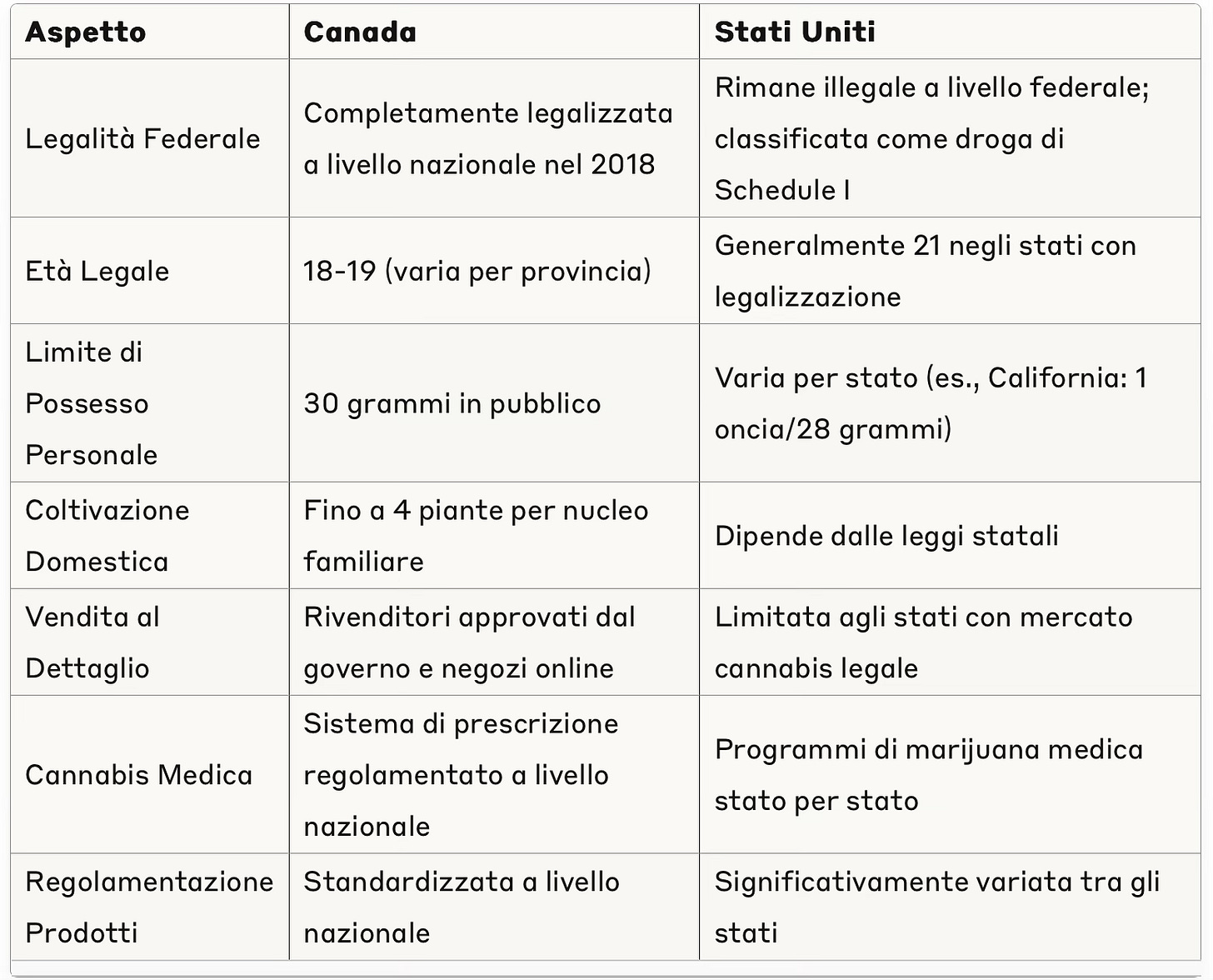From “Canadiana” to Cannabis/Da "Canadiana" alla cannabis
A Tale of Two Countries in a Puff/Il racconto di due Paesi in una fumata (il testo in italiano segue quello in inglese)
When we began thinking about what to call our newsletter, we found ourselves drawn to the name Canadiana. It carried the right mix of nostalgia, national identity, and intellectual appeal—conjuring images of maple leaves, curling rinks, and the gentle hum of CBC Radio. It felt solid, grounded, and perhaps just quirky enough to intrigue.
Alas, a quick search revealed that Canadiana was already spoken for on Substack. And when we floated the name by a few younger Canadians, their response was immediate—and a touch deflating. “Canadiana? Sounds like a weed brand.” We chuckled. But the remark lingered.
Curious, we looked into it. Was Canadiana actually the name of a cannabis brand? As it turns out, no – though frankly, it could be. With product names like “Oceanic Releaf,” “Broken Coast,” and “Canaca” populating the shelves, the overlap between national branding and cannabis marketing has become surprisingly easy to imagine (see here a list of colourful cannabis brands currently on sale in Canada). If nothing else, the offhand comment from Gen Z offered a reminder: cultural references shift quickly, and even the most traditional-sounding names can take on unexpected meanings when filtered through younger audiences.
It also led us to reflect on how cannabis—legal, normalized, and increasingly stylized in Canada—can act as a mirror for larger cultural and political contrasts between this country and its southern neighbour. Now more than ever, it seems that every aspect of Canada’s identity is inevitably measured against the American yardstick—judged by how things are done, or perceived, south of the border. And so, even cannabis can become a geopolitical lens, offering a glimpse into how Canada and the United States see and compare themselves.
Canada: A National Approach to Legalization
Since the passage of the Cannabis Act (Bill C-45) in October 2018, Canada has had a clear, federally regulated framework for both recreational and medical marijuana. Each province sets its own legal age—either 18 or 19—and adults are permitted to carry up to 30 grams of dried cannabis in public. Personal cultivation of up to four plants per household is allowed, though some provinces impose additional restrictions.
Legal retail options range from government-run stores to privately licensed dispensaries, many of which look more like high-end design boutiques than what older generations might associate with cannabis culture. Public consumption is generally permitted but subject to local regulations. Patients requiring medical cannabis can access it through prescriptions, either by growing their own or purchasing it from licensed providers. Medical cannabis remains available through licensed providers, and the 2019 legalization of edibles and derivatives added further layers of regulation and consumer choice.
In short, Canada’s system is comprehensive, tightly governed, and relatively straightforward.
Alchemy Cannabis Dispensary in Toronto, by Paolo Ferrari Studio
The United States: A Patchwork of Contradictions
By contrast, the American approach to cannabis remains fragmented and fraught. At the federal level, marijuana remains illegal and is classified as a Schedule I drug – in the same category as heroin, just to be clear. As of 2024 24 states—including all those on the West Coast, from Washington to Arizona—have legalized recreational cannabis.
Each state has its own rules around possession, cultivation, sales, and public use, with wildly varying degrees of enforcement. In most of these states, the legal age for cannabis use is 21. Possession limits vary; for instance, California permits up to 1 ounce (28 grams). Home cultivation rules also differ.
Medical marijuana is legal in 39 states, but cannabis businesses continue to face significant challenges due to federal restrictions, including limited banking options and legal ambiguities that complicate interstate commerce. While cannabis can be legally purchased in certain states, transporting it across state lines remains prohibited.
In short, the U.S. landscape is inconsistent and often confusing. While legal in one jurisdiction, cannabis possession or transport can still lead to arrest just a few miles down the road.
A Cultural Reflection
What began as a playful attempt to name a newsletter evolved into a broader reflection on how two neighbouring countries regulate—and symbolize—an increasingly normalized aspect of modern life. Canada has adopted a unified, federally sanctioned model, rooted in public health and regulatory clarity, which also allows for a more accurate analysis of the costs and benefits, risks and opportunities of certain policy implementations (see, for example, the Canadian Cannabis Survey 2024 and StatCan). The United States, true to form, has taken a decentralized, state-by-state approach that reveals more about internal tensions than it does about national policy coherence.
As for Canadiana, we dropped it as our final title for the newsletter. But the detour it inspired reminded us why we do this work in the first place: to explore the surprising intersections between culture, politics/policy, and perception—sometimes with a touch of humour, always with curiosity.
Scarlet Fire Cannabis Dispensary in Toronto /Images from SevenPoint Interiors, courtesy of e-architect
Da “Canadiana” alla cannabis
Il racconto di due Paesi in una fumata
Quando abbiamo iniziato a riflettere sul nome da dare alla nostra newsletter, Canadiana ci è sembrato subito quello giusto. Evoca, perlomeno in noi, immagini di praterie sconfinate, foreste di aceri, partite di hockey su ghiaccio, modernità multiculturale. Il tutto accompagnato dal rassicurante sottofondo della CBC Radio. Un nome quindi che suonava solido, radicato nel territorio, e con quel pizzico di eccentricità che incuriosisce.
Purtroppo, una rapida ricerca su Substack ci ha fatto scoprire che il nome era già stato preso. Ma il vero colpo di grazia è arrivato quando abbiamo sottoposto l’idea a un gruppo di giovani canadesi. La loro reazione è stata secca e un po’ spiazzante: “Canadiana? Sembra un marchio di cannabis.” Ne abbiamo sorriso, sì. Ma abbiamo preso nota e, incuriositi, abbiamo indagato.
Canadiana era davvero il nome di un marchio di cannabis? No, anche se, francamente, avrebbe davvero potuto esserlo. Con nomi di prodotti come "Oceanic Releaf", "Broken Coast" e "Canaca" sugli scaffali, il confine tra branding nazionale e marketing della cannabis è diventato sorprendentemente labile (vedi qui un elenco di marchi di cannabis attualmente in vendita in Canada). Resta il fatto che è stata la sincerità di un Gen Z a ricordarci che i riferimenti culturali cambiano rapidamente, al punto che anche nomi ossificati dalla tradizione possono assumere significati inaspettati quando filtrati attraverso le lenti dei più giovani. Il che ci ha anche fatto riflettere su come la cannabis – legale, accettata e “modaiola” in Canada ma ancora uno stupefacente a tutti gli effetti in molte parti degli USA – possa diventare uno specchio che immancabilmente riflette le differenze culturali, politiche e sociali sempre in gioco tra i due lati del confine: Canada da una parte, Stati Uniti dall’altra.
Il Canada: un modello nazionale e regolato
Dal 2018, con l’entrata in vigore del Cannabis Act (Bill C-45), il Canada ha adottato un quadro normativo chiaro e uniforme per l’uso ricreativo e terapeutico della cannabis. L’età legale varia da provincia a provincia (18 o 19 anni), e ogni adulto può possedere fino a 30 grammi di cannabis essiccata per uso personale. È consentita anche la coltivazione domestica—fino a quattro piante per abitazione—salvo ulteriori restrizioni locali.
La vendita è affidata a rivenditori autorizzati, pubblici o privati, spesso lontani anni luce dall’immaginario collettivo legato ai vecchi coffee shop: ambienti eleganti, minimalisti, che sembrano usciti da un catalogo di design. Il consumo in pubblico è generalmente consentito, sebbene soggetto a regolamenti municipali, e tranquillamente praticato. A Vancouver, per esempio non è raro camminare per strada, sentire l’inconfondibile ‘zaffata’, guardarsi attorno per scoprire il ‘colpevole’, e vedere solo signori attempati o signore dall’aria tutto fuorché alternativa. Quanto alla cannabis terapeutica, è necessaria la prescrizione, e dal 2019 sono legali anche edibili e derivati, seppur sotto rigido controllo normativo.
Un sistema, insomma, strutturato, coerente, e di facile lettura.
Il banco di vendita del negozio GreenHead Cannabis a Vancouver (per gentile concessione di “Cannabis Chronichles”)
Gli Stati Uniti: un puzzle normativo
Negli Stati Uniti, la situazione è decisamente più complessa. A livello federale, la marijuana è ancora illegale ed è classificata come sostanza di Classe I—alla pari dell’eroina, tanto per intenderci. Eppure, sono ormai 24 gli stati (compresi tutti quelli della costa ovest) che hanno legalizzato l’uso ricreativo della cannabis.
L’età legale è quasi ovunque fissata a 21 anni, ma ogni stato fa storia a sé per quanto riguarda quantità, modalità di consumo, coltivazione domestica e punti vendita. In California, il più liberale degli Stati e l’unico che si avvicina ai quantitativi legali canadesi, si possono possedere fino a 28 grammi. Attraversare il confine tra stati in possesso di marijuana è vietato e può comportare conseguenze legali anche gravi.
La cannabis terapeutica è permessa in 39 stati, ma i produttori e i rivenditori devono fare i conti con limiti bancari, ambiguità normative e restrizioni federali che rendono difficile anche il solo operare.
Risultato? Un mosaico incoerente e spesso contraddittorio. Dove oggi la cannabis è legale, domani potrebbe non esserlo. Dove si può acquistare, non sempre si può trasportare.
Uno specchio culturale
Quello che era nato come un semplice brainstorming per trovare un nome alla newsletter si è trasformato in un’occasione per riflettere su come due paesi confinanti gestiscano—e interpretino—a modo loro un fenomeno in costante evoluzione. Il Canada ha puntato su una struttura nazionale, chiara, ispirata a principi di salute pubblica che consentono anche di analizzare con maggiore accuratezza costi e benefici, rischi e opportunità di certe implementazioni (vedi per es. Canadian Cannabis Survey 2024 e StatCan). Gli Stati Uniti hanno optato per il tradizionale patchwork destrutturato: regolamenti statali, tensioni federali e tanta, tantissima incertezza.
E Canadiana? Il nome l’abbiamo lasciato andare. Ma questa deviazione di percorso ci ha ricordato perché facciamo questo lavoro: per raccontare le intersezioni, sempre illuminanti, tra cultura, politica/politiche, percezione e immaginari collettivi – quando possibile, anche con un pizzico d’ironia.
.










